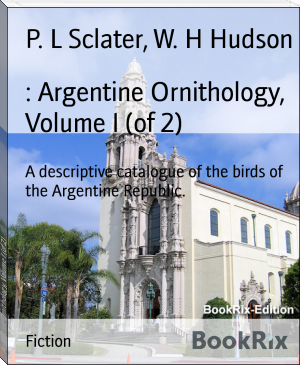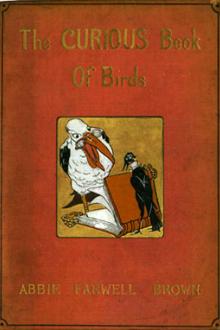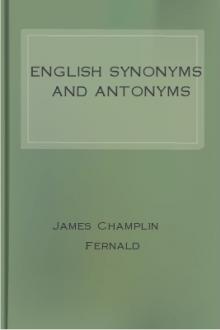: Argentine Ornithology, Volume I (of 2), P. L Sclater, W. H Hudson [best authors to read txt] 📗

- Author: P. L Sclater, W. H Hudson
Book online «: Argentine Ornithology, Volume I (of 2), P. L Sclater, W. H Hudson [best authors to read txt] 📗». Author P. L Sclater, W. H Hudson
tail 3·0. _Female_ similar.
_Hab._ Paraguay and Northern Argentina.
This species was met with by Durnford near Salta in June 1878. He
describes the iris as "light rufous; upper mandible dark slate, under
mandible, legs, and feet pale slate."
Mr. Salvin founded his _C. altirostris_ upon Durnford's specimens, but
Graf v. Berlepsch is of opinion that this species is the "_Habia verde_"
of Azara, and should consequently bear the name "_viridis_" of Vieillot.
This is perhaps correct, but at the same time it would only make fresh
confusion to transfer to this species the name hitherto usually applied
to the preceding bird. We prefer, consequently, to let it stand under
Mr. Salvin's name "_altirostris_."
Fam. (VIII. HIRUNDINIDÆ, or SWALLOWS.)
The cosmopolitan family of Swallows, of which about eighty species
are known, is well developed in the New World, where some thirty
representatives occur in various parts. In Argentina the occurrence of
eight Swallows has been recorded. Three of them belong to the group of
Purple Martins (_Progne_), which is restricted to the New World, and
of the remainder four are members of genera entirely restricted to the
Neotropical Region. The genus _Petrochelidon_, of which one species
is met with in La Plata, has alone representatives in the Eastern
Hemisphere.
25. PROGNE FURCATA, Baird[3]. (PURPLE MARTIN.)+Progne purpurea+, _Hudson, P. Z. S._ 1872, p. 548 (Patagonia);
_Scl. P. Z. S._ 1872, p. 605; _Scl. et Salv. Nomencl._ p. 14;
_Durnford, Ibis_, 1877, p. 32 (Chupat), 1878, p. 392 (Central
Patagonia); _White, P. Z. S._ 1882, p. 595 (Buenos Ayres).
+Progne elegans+, _Barrows, Bull. Nutt. Orn. Cl._ viii. p. 89
(Bahia Blanca). +Progne furcata+, _Baird, Rev. A. B._ p. 278;
_Sharpe, Cat. A. B._ x. p. 175.
_Description._--Uniform deep purple-blue; on each side of the back a
small concealed tuft of white feathers; tail-feathers black, washed
with blue: total length 7·7 inches, wing 5·55, tail 3·3. _Female_:
upper parts dull purple; head, neck, and lower parts blackish brown.
_Hab._ Argentina and Patagonia.
The Purple Martin is occasionally seen in the eastern provinces of La
Plata when migrating, but has not been found nesting anywhere so far
north as Buenos Ayres. I met with it breeding at Bahia Blanca on the
Atlantic coast, and on the Rio Negro, where it is very common. It
arrives in Patagonia late in September, and leaves before the middle of
February. On the 14th of that month I saw one flock flying north, but it
was the last. It breeds in holes under the caves of houses or in walls,
and its nest is like that of _P. chalybea_; but many also breed in holes
in the steep banks of the Rio Negro. They do not, however, excavate
holes for themselves, but take possession of natural crevices and old
forsaken burrows of the Burrowing Parrot (_Conurus patachonicus_).
In size, flight, manners, and appearance the Purple Martin closely
resembles the following species, the only difference being in the dark
plumage of the under surface. The language of the two birds is also
identical; the loud excited scream when the nest is approached, the
various other notes when the birds sweep about in the air, and the
agreeably modulated and leisurely-uttered song are all possessed by the
two species without the slightest difference in strength or intonation.
This circumstance appears very remarkable to me, because, though two
species do sometimes possess a few notes alike, the greater part of
their language is generally different; also because birds of the same
species in different localities vary more in language than in any other
particular. This last observation, however, applies more to resident
than to migratory species.
[3] [I here follow Mr. Sharpe in considering the Purple Martin of
Argentina and Patagonia separable from the closely allied northern
species of North America. But I am altogether sceptical about its
occurrence in Chili, which Dr. Philippi expressly diaries (P. Z. S.
1868 p. 534) and for which I know of no good authority.--P. L. S.]
26. PROGNE CHALYBEA (Gm.). (DOMESTIC MARTIN.)
+Progne chalybea+, _Scl. P. Z. S._ 1872, p. 606 (Buenos Ayres); _Scl.
et Salv. Nomencl._ p. 14; _White, P. Z. S._ 1882, p. 595 (Buenos
Ayres); _Barrows, Bull. Nutt. Orn. Cl._ viii. p. 88 (Concepcion);
_Sharpe, Cat. B._ x. p. 178. +Progne domestica+, _Burm. La-Plata
Reise_, ii. p. 477; _Sharpe, Cat. B._ x. p. 177.
_Description._--Entire upper parts deep purple-blue; lesser and
median wing-coverts the same; wing- and tail-feathers black, glossed
with steel-blue; throat, fore neck, and chest ash colour; breast,
abdomen, and under tail-coverts pure white; bill and feet black:
total length 8 inches, wing 5·7, tail 3·2. _Female_ similar.
_Hab._ Central and South America.
This species, distinguished from the Purple Martin by its white
underparts, ranges from Mexico to Buenos Ayres, the extreme limit of
its range being about 250 miles south of that city. It was well called
_Golondrina domestica_ by Azara, being preeminently domestic in its
habits. It never breeds in banks as the Purple Martin often does, or in
the domed nests of other birds in trees, a situation always resorted to
by the Tree-Martin, and occasionally by the Common Swallow; but is so
accustomed to the companionship of man as to make its home in populous
towns as well as in country-houses. It arrives in Buenos Ayres about the
middle of September, and apparently resorts to the same breeding-place
every year. A hole under the eaves is usually selected, and the nest is
roughly built of dry grass, hair, feathers, and other materials. When
the entrance to its breeding-hole is too large, it partially closes it
up with mud mixed with straw; if there be two entrances it stops up one
altogether. The bird does not often require to use mud in building; it
is the only one of our Swallows that uses such a material at all. The
eggs are white, long, pointed, and five in number.
In the season of courtship this Martin is a noisy pugnacious bird, and
always, when quitting its nest, utters an exceedingly loud startling cry
several times repeated. It also has a song, uttered both when resting
and on the wing, composed of several agreeably modulated notes, and in
that thick rolling intonation peculiar to our Swallows. This song does
not sound loud when near, yet it can be distinctly heard when the bird
appears but a speck in the distance. I may here remark that, with the
exception of the _Petrochelidon pyrrhonota_, which possesses a sharp
squeaky voice, like the Swallows of Europe, all our Hirundines have soft
voices: their usual twittering when they are circling about resembles
somewhat the chirping of the English House-Sparrow in tone, but besides
these notes they possess a song more pleasing to the ear.
Before leaving in February these birds congregate in parties of from
twenty to four or five hundred, usually on the broad leafy top of an old
ombú tree.
27. PROGNE TAPERA (Linn.). (TREE-MARTIN.)
+Progne tapera+, _Scl. P. Z. S._ 1872, p. 606 (Buenos Ayres); _Scl.
et Salv. Nomencl._ p. 14; _Durnford, Ibis_, 1877, p. 168 (Buenos
Ayres); _White, P. Z. S._ 1882, p. 595 (Catamarca); _Barrows,
Bull. Nutt. Orn. Cl._ viii. p. 89 (Concepcion); _Sharpe, Cat. B._
p. 180. +Cotyle tapera+, _Burm. La-Plata Reise_, ii. p. 477.
_Description._--Entire upper parts dull brown; tail-feathers
blackish brown; throat ashy white; fore neck and chest ashy brown
in the centre and dark brown on the sides, as are also the flanks;
abdomen white; bill and feet horn-colour: total length 7 inches,
wing 5·5, tail 2·6. _Female_ similar.
_Hab._ Brazil, Paraguay, Argentina.
The Tree-Martin is more slender and has a greater extent of wing than
the Purple Martins; and, instead of the beautiful dark purple (their
prevailing colour), its entire upper plumage is dusky brown, the under
surface white. But if these differences of structure and hue merely
serve to show that it is not a very near relative of the other species,
those exhibited in its habits remove it very far indeed from them.
The Tree-Martin is a very garrulous bird, and no sooner arrives early in
September, than we are apprised of the circumstance by the notes which
the male and female incessantly sing in concert, fluttering and waving
their wings the while, and seeming quite beside themselves with joy at
their safe arrival; for invariably they arrive already mated. Their
language is more varied, the intonation bolder and freer than that of
our other Swallows. The length of the notes can be varied at pleasure;
some are almost harsh, others silvery or liquid, as of trickling drops
of water; they all have a glad sound; and many have that peculiar
character of some bird-notes of shaping themselves into words.
This Martin is never seen to alight on the ground or on the roofs of
houses, but solely on trees; and when engaged in collecting materials
for its nest, it sweeps down and snatches up a feather or straw without
touching the surface. It breeds only in the clay-ovens of the Oven-bird
(_Furnarius rufus_). I, at least, have never seen them breed in any
other situation after observing them for a great many summers. An
extraordinary habit! for, many as are the species that possess the
parasitical tendency of breeding in other birds' nests, none of them
confine themselves to the nest of a single species excepting the bird
I am describing. It must, however, be understood that my knowledge of
this bird has been acquired in Buenos Ayres, where I have observed it;
and as this Martin possesses a wider range in South America than the
Oven-birds, it is more than probable that in other districts





Comments (0)